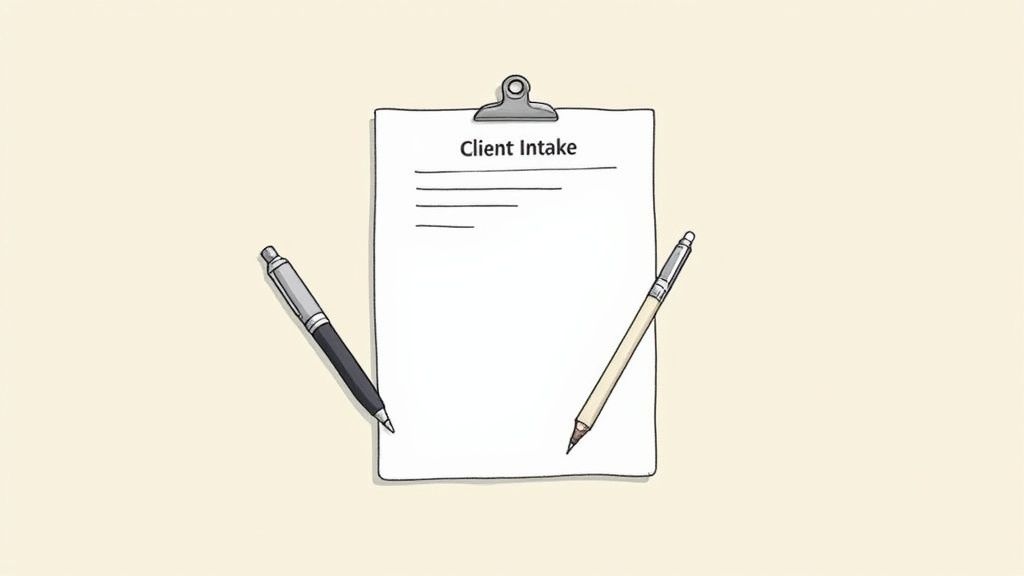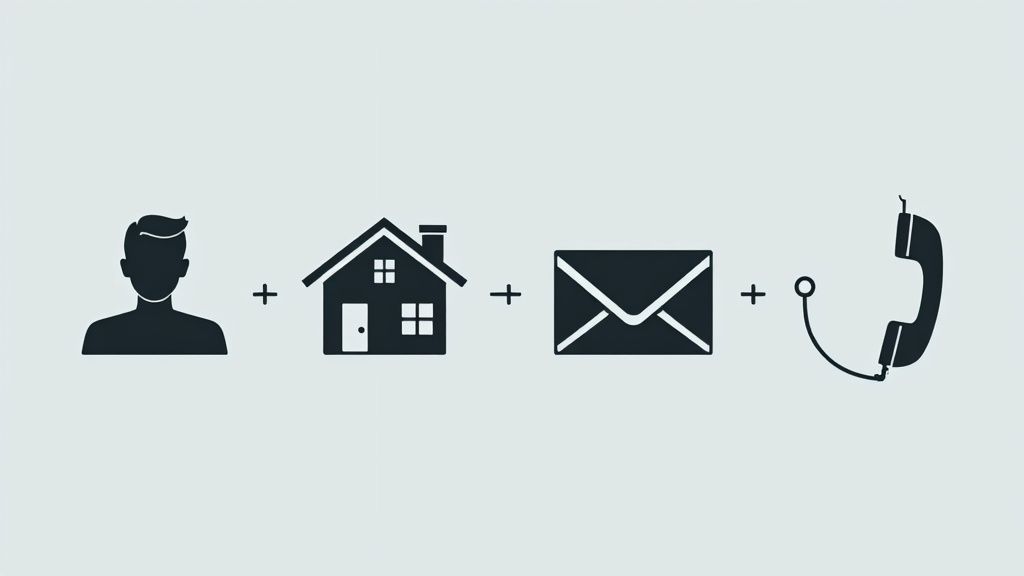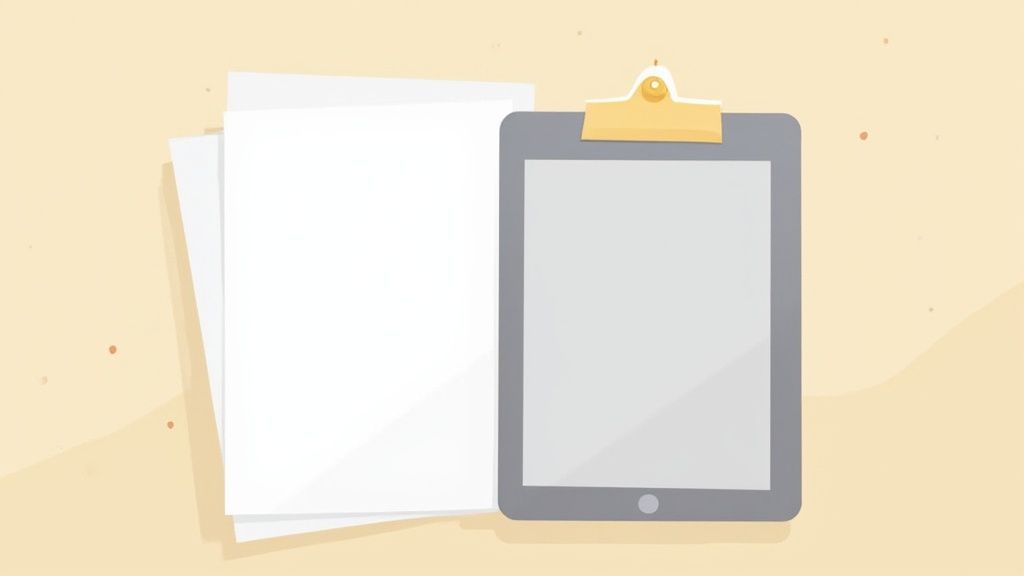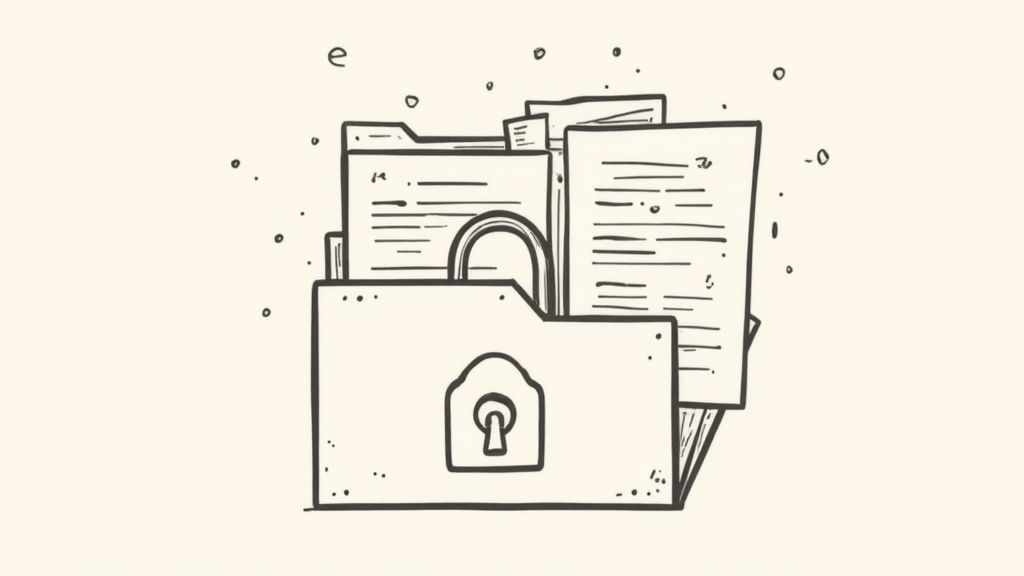When a new client walks through your door (or, more likely these days, fills out a form on your website), the very first documents they see are your legal client intake documents. These aren't just forms to fill out. They are the first handshake, the initial conversation, and the blueprint for your entire professional relationship.
This is your chance to gather crucial information, check for potential conflicts, and clearly lay out the rules of the road for your engagement. A solid intake process is the foundation upon which trust and clear expectations are built.
Why Your First Client Conversation Matters

Think of your firm's intake process as more than just paperwork; it’s the very start of the attorney-client relationship. A disorganized or confusing intake can plant seeds of doubt right from the beginning. On the other hand, a smooth, professional, and empathetic process shows a potential client they've come to the right place.
A sloppy intake doesn't just feel unprofessional—it hits your bottom line. Research shows that law firms lose an average of 8% of potential revenue simply because of a clumsy intake system. If your average client value is $10,000, fumbling the intake for just eight clients means you've left $80,000 on the table. For a deeper dive, check out this report on key law firm metrics.
To better understand their role, let's break down the core functions these documents serve. They are the essential administrative and ethical tools that protect both your firm and your clients.
Core Functions of Legal Intake Documents
| Function | Purpose and Importance |
|---|---|
| Information Gathering | To collect the fundamental details needed to understand the case, such as contact information, facts of the matter, and key dates. |
| Conflict Checking | To fulfill the ethical duty of ensuring that representing the new client does not create a conflict of interest with any current or past clients. |
| Relationship Formalization | To establish clear expectations regarding the scope of work, fees, and responsibilities through an engagement letter or fee agreement. |
| Expectation Management | To define the boundaries of the relationship, clarifying what the client can expect from the firm and what the firm requires from the client. |
In short, these documents are the first, most tangible proof of your firm’s competence and attention to detail.
A well-oiled intake process is one of the most powerful client service tools you have. It signals professionalism and organization, assuring the client that their important legal matter is in capable and caring hands.
Building Your Essential Intake Document Toolkit

Putting together your intake packet is a bit like packing a toolkit for a very specific job. You wouldn't bring a sledgehammer to fix a watch, right? In the same way, every legal client intake document serves a unique and vital purpose. When used together, they create a comprehensive case file that protects your firm and starts the client relationship off on the right foot.
Think of these documents as the foundation of a house. Each one gathers a different, critical piece of information, and together they build a strong, stable structure for the entire case. Let's walk through the essential tools you'll need in your kit.
The Initial Client Intake Form
This is your first and most important information-gathering tool. The goal here is simple: capture all the crucial contact details and the basic facts of the case right away. A well-designed intake form is the first domino to fall in creating an organized and efficient workflow.
A solid intake form should always capture:
- Full legal name and contact information: This includes their phone number, email, and physical address.
- Key dates and deadlines: You need to know about things like the statute of limitations from day one.
- A brief summary of the legal issue: Get it down in the client's own words.
- Names of all opposing parties: This is absolutely critical for the next step.
The Conflict Of Interest Check Form
This one is non-negotiable. It's a purely internal document, but it's one of the most important you'll handle. Before you even think about moving forward, your firm has an ethical duty to make sure that representing this new client won't create a conflict with any of your current or even former clients. This form makes that process routine.
Typically, it just lists the new client and any adverse parties. Your team then runs those names against your firm's entire client database. Skipping this step isn't just sloppy—it can lead to serious ethical violations and even get you disqualified from a case.
A conflict check is your firm's ethical safeguard. It's an internal due diligence step that must be completed and documented before any substantive legal work begins.
The Fee Agreement or Engagement Letter
Once you’ve cleared the conflict check and decided to take the case, it’s time to make it official. The fee agreement (or engagement letter) is arguably the most critical document in your toolkit because it defines the entire professional relationship from start to finish.
This is a legally binding contract that clearly lays out:
- Scope of Representation: What legal services will you provide? Just as important, what will you not be doing? Be specific.
- Fee Structure: This section explains how you get paid. Is it an hourly rate, a flat fee, or a contingency? It should also detail your billing practices.
- Client Responsibilities: What do you need from the client? This can include things like providing documents and information in a timely manner.
This entire intake process is just the first phase of a much larger client journey. For a complete overview, you can explore this detailed client onboarding checklist to see how these documents fit into the bigger picture.
When building out your toolkit, you might also want to include examples of common family law forms if that's a core part of your practice.
Authorization for Release of Information
Finally, most cases require you to get records from third parties—think hospitals, banks, police departments, or other government agencies. You can't just call them up and ask for files. The Authorization for Release of Information form, signed by your client, gives you the legal authority to request and receive these confidential documents on their behalf.
Without this signed form, your hands are tied, and you simply can't gather the evidence you need to build a winning case.
How Intake Failures Cost Your Firm Clients

Your firm's intake process is the first real handshake with a potential client. It's their very first taste of what it’s like to work with you. If that first interaction is clumsy, confusing, or slow, it doesn't just create an internal headache—it actively costs you business.
Think about it from their perspective. Someone is likely reaching out under stress, looking for a capable professional to solve a serious problem. When they’re met with a long delay, a complicated form, or radio silence, their confidence evaporates. That poor first impression is often all it takes to send them looking elsewhere. Each time this happens, thousands of dollars in potential fees walk right out the door to a competitor who was ready and waiting.
The Real Cost of a Single Missed Detail
Let's walk through a common, and costly, scenario. A potential client, we'll call her Sarah, is facing a time-sensitive contract dispute and calls your firm. The person who answers is busy and, in a rush, jots down her name and number but forgets to ask for an email. Worse, they transpose two digits in her phone number.
Days go by, and Sarah hears nothing. She assumes your firm isn't interested or is simply disorganized. Meanwhile, your team tries to follow up, but the number is wrong, and you have no other way to contact her. By the time anyone realizes the mistake, Sarah has already hired another firm that got her details right and scheduled a consultation the same day. You didn’t just lose one case; you lost Sarah’s future business and any referrals she might have sent.
This isn't just a story; it's a reflection of a massive industry-wide blind spot. The data is startling. An incredible 86% of firms don't bother to collect a client's email address on the initial call, and 45% fail to even get a phone number. What’s more, a full 35% of calls from potential clients go completely unanswered.
Think of your intake process as the front door to your firm. If that door is locked or broken, people won't wait around—they'll just go next door. A single weak link can make all your marketing efforts completely pointless.
Plugging the Leaks in Your Client Funnel
The only way to stop bleeding these valuable leads is to treat your intake system with the seriousness it deserves. It’s not just admin work; it's a core business function. The goal is to build a reliable, repeatable process that guarantees every single inquiry is handled professionally and efficiently.
Here’s where to focus your efforts:
- Standardize Everything: Create a simple, mandatory script or checklist for every team member. This ensures you capture the same crucial information every single time, without fail.
- Respond Immediately: Set a firm-wide rule for follow-up times. A potential client should get some kind of acknowledgment within minutes, not hours or days.
- Centralize Your Data: Use a dedicated system to log every piece of information instantly. This gets rid of sticky notes, scraps of paper, and the risk of human error.
Optimizing how you collect documents from clients turns your intake from a liability into one of your best tools for winning new business. It’s all about creating a smooth, professional journey from the very first hello.
Navigating Compliance and Ethical Duties

Your legal client intake documents are much more than just a way to gather case details. They are your firm’s first and most important line of defense against some serious legal and ethical pitfalls. These duties aren’t just suggestions—they are fundamental responsibilities that protect your firm, your clients, and the profession's integrity.
Think of it like the pre-flight check a pilot performs. A pilot wouldn't dream of taking off without verifying the plane's condition. In the same way, you must verify a client's identity and the source of their funds before you ever get their case off the ground. Skipping this step is asking for serious turbulence later on.
Understanding Your Due Diligence Obligations
Two of the most critical duties you'll handle during intake are Anti-Money Laundering (AML) checks and thorough Client Due Diligence (CDD). These aren't just boxes to tick; they are active, ongoing processes. AML rules, for instance, demand that you stay alert for any suspicious financial activity, especially in areas like real estate or corporate transactions.
Client Due Diligence is all about making sure your clients are who they claim to be. This becomes incredibly important when you're working with:
- High-risk clients: People or companies from places with known weak AML regulations.
- Complex ownership structures: Businesses that use layers of shell companies to obscure the true owner.
- Large cash transactions: Any time a significant amount of cash is involved and its origin isn't crystal clear.
Dropping the ball here has serious consequences. In the first quarter of 2024 alone, the SRA launched over ten enforcement actions against law firms for AML breaches, with fines climbing as high as £170,000. The most common misstep? Not doing enough due diligence, particularly when it came to checking funds from overseas. You can learn more about these actions and the need for solid client vetting by reading up on how law firms can improve client intake.
Upholding Client Confidentiality and Data Privacy
From the very first phone call, you have an ethical duty to protect a potential client's information. This principle of client confidentiality is the foundation of the entire attorney-client relationship. Your intake process has to be built from the ground up to protect this sensitive data.
Your intake forms and digital systems are the gatekeepers of your clients' most private information. A breach at this early stage doesn't just violate privacy laws—it shatters the trust your entire professional relationship is built on.
This duty goes beyond just keeping quiet. With data privacy laws like GDPR and CCPA now in full force, you have a legal obligation to manage personal data securely. That means your legal client intake documents, whether on paper or on a screen, demand the highest level of care. You need secure storage, restricted access, and clear rules for how long you keep the data and how you destroy it. A failure here isn't just an ethical misstep; it's a huge legal and financial risk.
Modernizing Your Client Intake Process
Let’s be honest: clunky, paper-based systems are more than just an internal headache. They create a terrible first impression for new clients. Moving away from stacks of paper, tedious manual data entry, and the old "print, sign, scan" routine isn’t just about looking modern. It's a smart decision that makes your firm more efficient, secure, and genuinely client-friendly.
Think about the classic, frustrating process. A client has to print a form, sign it, find a scanner, and then email the file back to you. Then, someone on your team has to squint at the scanned document and manually type all that information into your case management system. Every single step is a potential point of failure—a delay, a lost document, or a critical data entry error.
The Shift to Digital Workflows
Today's tools completely change this picture. Things like secure online forms, dedicated client relationship management (CRM) software, and e-signatures are the foundation of a much better intake system. What was once a multi-step, error-filled chore becomes a single, smooth digital experience for the client.
This digital approach brings real, measurable benefits that directly boost your firm's bottom line:
- Improved Accuracy: When clients enter their own information directly, you virtually eliminate the typos and mistakes that inevitably creep in during manual data entry.
- Faster Turnaround Times: Digital forms and e-signatures can be filled out and sent back in minutes from a phone or computer. No more waiting days for someone to get to a printer.
- Automated Reminders: The right software can automatically nudge clients who haven't finished their forms, saving your staff from hours of administrative follow-up.
- Seamless Integration: The best part? The data collected can flow directly into your case management software, instantly creating new client files without any copy-pasting.
By bringing these tools into your practice, you change client intake from a necessary evil into a professional, polished experience that sets a positive tone. This change is a core part of effective document workflow automation, which can free up countless hours and cut down on administrative drag across your entire firm.
Traditional vs. Digital Intake Process
To really see the difference, it helps to put the old way and the new way side-by-side. The contrast shows just how much you stand to gain by making the switch.
| Fonctionnalité | Traditional (Paper) Process | Modern (Digital) Process |
|---|---|---|
| Data Entry | Manual, time-consuming, and prone to errors. | Automated, instant, and highly accurate. |
| Client Experience | Cumbersome, slow, and requires extra equipment. | Fast, convenient, and easy on any device. |
| Security | Risk of lost or misplaced physical papers. | Secure, with encrypted data and clear audit trails. |
| Efficiency | Labor-intensive with constant delays. | Highly efficient with automated workflows. |
| Document Management | Physical storage, difficult to search. | Centralized, searchable, and instantly accessible. |
The move to digital isn't just an upgrade—it's a fundamental improvement in how you operate, giving you back time and giving your clients a better experience from day one.
Choosing Your Modern Toolkit
The first step is picking the right software. You need a platform that is secure, dead simple for clients to use, and plays nicely with the other systems you already have. Just as important is designing your digital forms thoughtfully. They should be clear, concise, and broken into logical chunks to keep the client from feeling overwhelmed.
For a deeper dive into building great client relationships from the start, especially as you update your processes, these client onboarding best practices are a fantastic resource. They offer valuable ideas that pair perfectly with a digital-first mindset.
A modern intake system shows clients you value their time and take their security seriously. It’s an immediate signal of professionalism and competence from the very first interaction.
Common Questions About Legal Intake Documents
As law firms work on improving their processes, a few questions about client intake documents pop up again and again. Getting these answers right helps set clear priorities and guides the move toward better, more efficient systems that work for everyone—the firm and the clients.
These questions usually circle around which forms matter most, how technology fits into the picture, and whether these documents need to be updated. Let's dig into the answers.
What Is the Single Most Important Intake Document?
While every piece of your intake packet has a job to do, the engagement letter or fee agreement is easily the most critical. You can think of it as the foundation of your entire attorney-client relationship. It's the binding contract that officially kicks things off.
This one document lays out the scope of the work, explains the fee structure from top to bottom, and clarifies what your firm will do and what the client needs to do. A well-written engagement letter is your best tool for preventing future confusion, setting client expectations from day one, and giving you something solid to refer back to if a disagreement ever comes up.
How Does Technology Improve Client Intake?
Technology takes client intake from a slow, paper-shuffling headache to a fast, accurate, and genuinely pleasant experience for your clients. Instead of mailing or handing over a stack of forms, clients can fill everything out through a secure online portal on their own time, from any device.
This shift to digital brings some huge wins:
- Eliminates Errors: It gets rid of typos and mistakes from manual data entry, so the information you have is correct from the start.
- Speeds Up Onboarding: With e-signatures and digital forms, you can shrink the onboarding timeline from days down to minutes.
- Enhances Client Experience: A smooth, modern process immediately tells clients you respect their time and run an organized, professional firm.
Using modern tools for your legal intake isn't just about being more efficient. It's about delivering a better standard of service that builds your client's trust from the very first conversation.
How Often Should We Update Our Intake Forms?
Your intake documents shouldn't be a "set it and forget it" affair. It’s a good practice to review and update them at least once a year, or sooner if there are major legal or regulatory changes. Laws around data privacy, AML rules, and professional ethics are always evolving, and your forms need to keep up.
On top of that, your own firm changes. You might add a new practice area or adjust your fee structures. Regular reviews make sure your intake documents always match your current services and internal policies, which keeps your firm protected and running smoothly.
Ready to stop chasing paperwork and create a seamless intake experience? Superdocu provides the tools you need to automate document collection, send reminders, and manage client information securely. Learn how Superdocu can transform your firm's intake process today.
